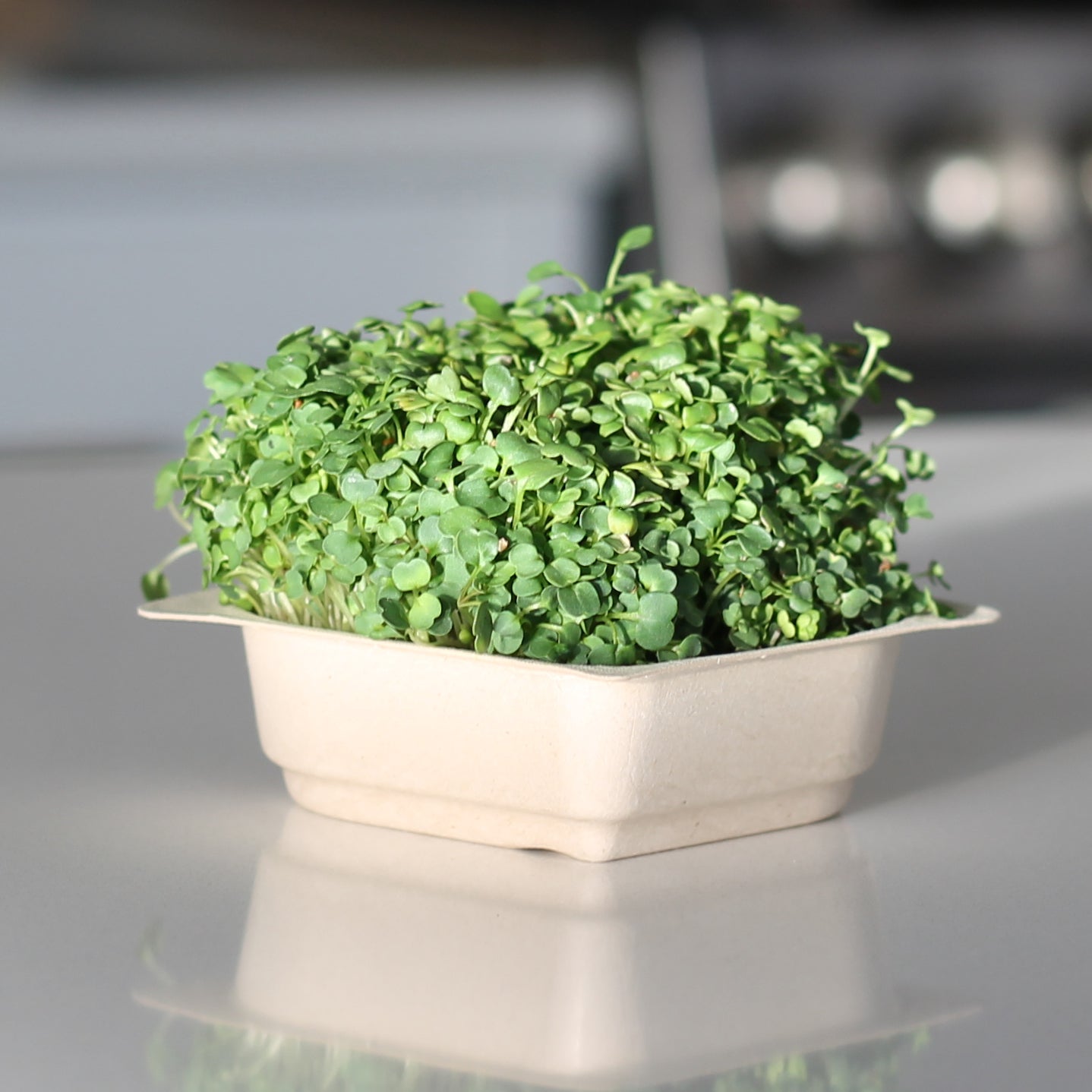Arugula Microgreens Health Benefits and Culinary Tips

You’ve probably come across alfalfa sprouts, pea shoots, or even kale microgreens at your local farmer’s market or natural foods grocery store. But what about arugula microgreens? Why would you want to try them, and what are they good for?
What Are Arugula Microgreens?
Arugula microgreens are the young seedlings of the arugula plant (Eruca sativa), known in Europe as “rocket.” Arugula is native to the Mediterranean region. It’s also a member of the Brassica family, along with broccoli, kale, and cabbage. [1]
While the full leaves are excellent in salads and quiches, microgreens are extra concentrated versions of the full plant. To enjoy the benefits of microgreens, the plants are harvested early in their growth, within 7 to 14 days after germination. That’s typically right after the first set of leaves develops and you’re picking tiny green plants: microgreens. [2,3]
Microgreens in general are loved for their intense flavors and concentrated nutrients compared to fully matured plants. Arugula is especially known for its peppery, mustard-like flavor.
Nutritional Benefits
Though research is still being done on the benefits of arugula microgreens, a promising study was published in September 2024 that found these tiny greens are high in flavonoids, a type of polyphenol. [4] In addition to having antioxidant and anti-inflammatory properties, flavonoids can help to protect against neurodegenerative diseases, cancer, and cardiovascular disease. [5]
Researchers also found that arugula microgreens were high in stilbenes, which are anti-inflammatory compounds.
Though the nutritional content of microgreens may vary in comparison to their full-grown counterparts, we can still assume some similar health benefits when looking at the nutritional value of arugula.
- Antioxidant Support: Adult arugula is rich in vitamins A and C—which are considered antioxidant vitamins as they donate electrons to neutralize damaging, electron-stealing free radicals. Beta carotene and lutein in arugula are other antioxidants that help to protect cells from oxidative stress. [6,7]
- Anti-Inflammatory Properties: Glucosinolates, which are high in adult arugula and arugula microgreens have anti-inflammatory effects. They’re precursors to isothiocyanates, which can reduce inflammation by inhibiting pro-inflammatory pathways. [8]
- Cardiovascular Health: The anti-inflammatory properties in arugula microgreens help reduce damage to the circulatory system. Minerals like potassium and magnesium are also crucial for balanced blood pressure and cardiovascular health. [9,10]
- Immune Support: Vitamins A and C contribute to a robust immune system by regulating the production and function of white blood cells. The other vitamins, minerals, antioxidants, and phytochemicals work synergistically to support immune function. [11]
- Allergy Support: Eating arugula may help stabilize mast cells, keeping them from releasing large amounts of histamine. That’s due, in part, to compounds like quercetin and kaempferol, which are known mast cell stabilizers and may help to quell allergic symptoms. [12,13]
- Bone Health: Arugula provides both vitamin K1 and calcium, essential for bone health. Their anti-inflammatory properties also help to prevent bone loss due to chronic inflammation. [14]
How to Shop for Arugula Microgreens
It’s easy to find a supplier like Instafarm that offers arugula seed trays and automated growing systems so you don’t need to worry about maintaining the right lighting or water schedule. Their devices are something you can use whether you’re in a home, apartment, or a tiny house! Growing your own can be both cost-effective and rewarding. It’s also a type of gardening you can do all winter long.
If you want to dip your toes into microgreens before investing in an at-home automated growing device, local farmers markets usually offer fresher options than a grocery store. Some areas may be within shipping distance of various online vendors, though keep in mind they are fragile to ship once grown. However, the best option is to cultivate your own fresh microgreens from the comfort of your home.
How to Grow Arugula Microgreens
To grow arugula microgreens, you’ll need a shallow tray with soil or a hydroponic mat. Arugula plants require a good amount of light (natural or artificial) and temperatures between 60° and 75° F.
For watering, make sure the soil maintains consistent moisture without being waterlogged. Allow the seeds to grow until just after the first true leaves appear. Then, to harvest them, cut just above the soil line using scissors or a sharp knife.
Cooking with Arugula Microgreens
Arugula microgreens are commonly used to add a spicy kick to salads. They’re also a chef’s favorite for enhancing the presentation of soups, sandwiches, omelets, and other dishes. Their delicate stems and small, tender leaves range in color from deep green to slightly purple. Using them as a garnish to an artistically plated dish can add that last je ne sais quoi.
For everyday use, incorporate them into fruit smoothies using a high-speed blender. It’s an excellent way to get your leafy greens in while on the go. They’ll also add some extra zest and serve as a healthy pick-me-up.
Arugula microgreens work well in homemade dressings and pestos. Step beyond traditional herbs like basil and parsley and add arugula microgreens for a heightened flavor. While you can certainly cook them in egg dishes or as a part of wilted greens, consuming them raw can help retain key nutrients like vitamin C.
References:
- Tradition, Uses and Biodiversity of Rocket (Eruca sativa, Brassicaceae) in Israel on JSTOR [Internet]. Jstor.org. 2024 [cited 2024 Sep 23]. Available from: https://www.jstor.org/stable/4256115
- Xiao Z, Lester GE, Luo Y, Wang Q. Assessment of vitamin and carotenoid concentrations of emerging food products: Edible microgreens. Journal of Agricultural and Food Chemistry [Internet]. 2012 Jul 30;60(31):7644–51. Available from: https://pubs.acs.org/doi/abs/10.1021/jf300459b
- Bhaswant M, Shanmugam DK, Miyazawa T, Abe C, Miyazawa T. Microgreens-A Comprehensive Review of Bioactive Molecules and Health Benefits. Molecules (Basel, Switzerland) [Internet]. 2023 Jan 15;28(2):867. Available from: https://pubmed.ncbi.nlm.nih.gov/36677933/
- García-Pérez P, Tomas M, Rivera-Pérez A, Patrone V, Giuberti G, Capanoglu E, et al. Exploring the bioaccessibility of polyphenols and glucosinolates from Brassicaceae microgreens by combining metabolomics profiling and computational chemometrics. Food Chemistry. 2024 Sep;452:139565.
- Maan G, Sikdar B, Kumar A, Shukla R, Mishra A. Role of Flavonoids in Neurodegenerative Diseases: Limitations and Future Perspectives. Current Topics in Medicinal Chemistry. 2020 Jun 9;20(13):1169–94.
- FoodData Central [Internet]. Usda.gov. 2024 [cited 2024 Sep 23]. Available from: https://fdc.nal.usda.gov/fdc-app.html#/food-details/2345311/nutrients
- Theodosis-Nobelos, P., & Rekka, E. A. The Antioxidant Potential of Vitamins and Their Implication in Metabolic Abnormalities. Nutrients. 2024; 16(16): 2740. Available from: https://doi.org/10.3390/nu16162740
- Sturm C, Wagner AE. Brassica-Derived Plant Bioactives as Modulators of Chemopreventive and Inflammatory Signaling Pathways. International Journal of Molecular Sciences [Internet]. 2017 Sep 1 [cited 2020 Sep 18];18(9). Available from: https://www.ncbi.nlm.nih.gov/pmc/articles/PMC5618539/
- Houston MC, Harper KJ. Potassium, Magnesium, and Calcium: Their Role in Both the Cause and Treatment of Hypertension. The Journal of Clinical Hypertension. 2008 Jul;10(7):3–11.
- Houston M. The Role of Magnesium in Hypertension and Cardiovascular Disease. The Journal of Clinical Hypertension. 2011 Sep 26;13(11):843–7.
- Ibrahim RE, Walaa El-Houseiny, Amany Behairy, Azza M.A. Abo-Elmaaty, Al-Sagheer AA. The palliative role of Eruca sativa leaves dietary supplementation against oxidative stress, immunosuppression, and growth retardation in temperature-stressed Oreochromis niloticus. Journal of Thermal Biology. 2019 Aug 1;84:26–35.
- Weng Z, Zhang B, Asadi S, Sismanopoulos N, Butcher A, Fu X, et al. Quercetin Is More Effective than Cromolyn in Blocking Human Mast Cell Cytokine Release and Inhibits Contact Dermatitis and Photosensitivity in Humans. Taube C, editor. PLoS ONE. 2012 Mar 28;7(3):e33805.
- Bell, L., & Wagstaff, C. Rocket science: A review of phytochemical & health-related research in Eruca & Diplotaxis species. Food chemistry. 2019 Mar 30; X, 1: 100002. https://doi.org/10.1016/j.fochx.2018.100002
- Livshits G, Kalinkovich A. Targeting chronic inflammation as a potential adjuvant therapy for osteoporosis. Life Sciences. 2022 Oct;306:120847.
Betsy Schroeder
Betsy does research and writing for a few different websites in the natural health field after taking Masters level courses in Nutrition & Functional Medicine through the University of Western States.
More About The Author



